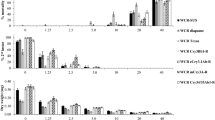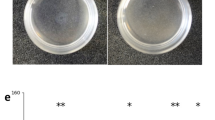Abstract
Bt corn is corn (Zea mays) that has been genetically modified to express insecticidal toxins derived from the bacterium Bacillus thuringiensis to kill lepidopteran pests feeding on these plants. Here we show that Bt toxin is released into the rhizosphere soil in root exudates from Bt corn.
Similar content being viewed by others
Main
The insecticidal toxin produced by B. thuringiensis subsp. kurstaki remains active in the soil, where it binds rapidly and tightly to clays1 and humic acids2. The bound toxin retains its insecticidal properties3 and is protected against microbial degradation by being bound to soil particles4, persisting in various soils for at least 234 days (the longest time studied), as determined by larvicidal bioassay5. Unlike the bacterium, which produces the toxin in a precursor form, Bt corn contains an inserted truncated cry1Ab gene that encodes the active toxin.
In laboratory studies, caterpillars of the monarch butterfly (Danaus plexippus) were killed as a result of feeding on milkweed (Asclepias curassavica) that had been artificially contaminated with pollen from transgenic corn that expressed the cry1Ab gene from B. thuringiensis subsp. kurstaki6, and green lacewings (Chrysoperla carnea), which are insect predators of insect pests, were killed by ingesting European corn borers (Ostrinia nubilalis) reared on Bt corn7.
We germinated surface-sterilized seeds8 of Bt corn (NK4640Bt) and of the isogenic strain without the cry1Ab gene on agar. The seedlings were aseptically placed on plastic screening (6-mm mesh), which, to minimize contamination by products of endosperm hydrolysis, was suspended over 200 ml of Hoagland's solution in 4-litre beakers covered with aluminium foil, which was removed after 18 to 20 days when the tops of the plants had reached it. After 7, 15 and 25 days of growth in a plant-growth room (2652°C, 12 h light–dark cycle), the soil-free medium was replaced with fresh solution and analysed.
Total protein in the medium (average of 105 mg protein per plant) was determined by the Lowry procedure9. A major band migrating on SDS–PAGE (sodium dodecyl sulphate–polyacrylamide gel electrophoresis) to a position corresponding to a relative molecular mass of 66,000 (66K), the same as that of the Cry1Ab protein, was evident after 7 and 15 days only in the exudates from Bt corn, although several protein bands of smaller relative molecular mass were seen in exudates from both Bt and non-Bt corn. We confirmed the presence of the toxin in the exudates from Bt corn by immunological assay with Lateral Flow Quickstix (from EnviroLogix, Maine; detection limit <10 parts per billion) and verified that it was active in an insecticidal bioassay using larvae of the tobacco hornworm (Manduca sexta), a model for testing antilepidopteran activity3,5.
Larvae placed on medium containing exudates from Bt corn stopped feeding and began to die after 2 to 3 days and had a mortality of 90 to 95% after 5 days (dose lethal to 50% of larvae, LC50, was 5.2 μg protein). There was no immunological reaction or larval mortality obtained with the exudates from non-Bt corn. After 25 days of growth, when the medium was no longer sterile (as demonstrated by streaking it on various microbiological media), the 66K band had disappeared, although there were several new protein bands of smaller relative molecular mass, and the immunological and larvicidal assays were negative, indicating that microbial, and probably also corn, proteases had hydro-lysed the toxin.
Samples of soil from the rhizosphere of seedlings that had been transplanted into either sterile or non-sterile soil in test-tubes were taken from randomly selected tubes, vortexed with extraction buffer (EnviroLogix) and centrifuged. We analysed the supernatants using the immunological and larvicidal assays and found that these were positive, even after 25 days of growth, for samples from Bt corn (100% mortality; LC50=1.6 μg protein per soil tube) but were negative for non-Bt corn. Moreover, particles of rhizosphere soil in suspension placed directly on the bioassay medium caused mortality comparable to the supernatants.
Although the concentration of protein in the rhizosphere soil was approximately 95 μg per g soil, the concentration of the actual toxin in the extraction buffer was apparently too low to be detected by SDS–PAGE. These results agree with earlier findings showing that the toxin binds rapidly to surface-active soil particles and that the bound toxin retains its larvicidal activity and is protected by this binding against biodegradation1,2,3,4,5.
About 15 million acres of Bt corn were planted in the United States in 1998, which was just under 20% of the total acreage of corn10. The Bt toxin that is released into soil from roots during the growth of a Bt corn crop would add to the amount of toxin introduced into soil from pollen during tasselling and as a result of the incorporation of plant residues after harvesting the crop.
We have no indication of how soil communities might be affected by Bt toxin in root exudates in the field. Bt toxin in the rhizosphere might improve the control of insect pests, or it might promote the selection of toxin-resistant target insects. Receptors for the toxin are present in non-target as well as target insects, so there may be a risk that non-target insects and organisms in higher trophic levels could be affected by the toxin. Further investigations will be necessary to shed light on what might happen underground.
References
Tapp, H., Calamai, L. & Stotzky, G. Soil Biol. Biochem. 26, 663–679 (1994).
Crecchio, C. & Stotzky, G. Soil Biol. Biochem. 30, 463–470 (1998).
Tapp, H. & Stotzky, G. Appl. Environ. Microbiol. 61, 1786–1790 (1995).
Koskella, J. & Stotzky, G. Appl. Environ. Microbiol. 63, 3561–3568 (1997).
Tapp, H. & Stotzky, G. Soil Biol. Biochem. 30, 471–476 (1998).
Losey, J. E., Raynor, L. S. & Carter, M. E. Nature 399, 214 (1999).
Hilbeck, A., Baumgartner, M., Fried, P. M. & Bigler, F. Environ. Entomol. 27, 480–487 (1998).
Benizri, E., Courtade, A. & Guckert, A. Soil Biol. Biochem. 27, 71–77 (1995).
Lowry, O. H., Rosebough, N. R., Farr, A. L. & Randall, R. J. J. Biol. Chem. 193, 265–275 (1951).
Wadman, M. Nature 397, 636 (1999).
Author information
Authors and Affiliations
Corresponding author
Rights and permissions
About this article
Cite this article
Saxena, D., Flores, S. & Stotzky, G. Insecticidal toxin in root exudates from Bt corn. Nature 402, 480 (1999). https://doi.org/10.1038/44997
Issue Date:
DOI: https://doi.org/10.1038/44997
This article is cited by
Comments
By submitting a comment you agree to abide by our Terms and Community Guidelines. If you find something abusive or that does not comply with our terms or guidelines please flag it as inappropriate.



